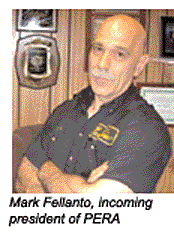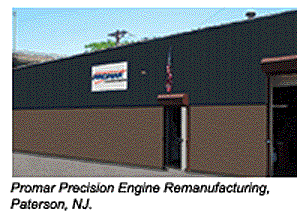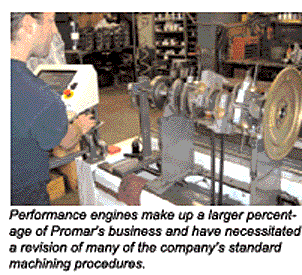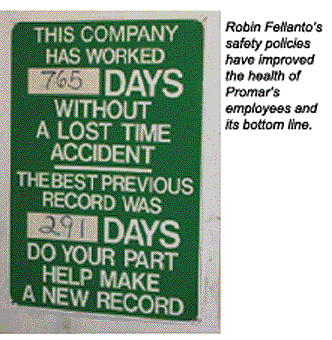On the surface, you might suppose that Mark Fellanto, incoming president of the Production Engine Remanufacturers Association (PERA) is a pretty simple fellow. You can set your watch by his daily routine. Even he admits that if someone was looking to do him in, he wouldn’t be hard to track down.

Fellanto rarely veers from his personal weekday schedule: he’s up at 5 a.m. and in the shop by 6; he conducts office business before and after he spends the work day on the shop floor. He’s on the road home at 6 p.m., has dinner at home with wife Robin, then off to the gym for a workout until 10:30. Back home again to sleep and start back again the next morning.
Routine? Certainly. But simple? Hardly. The complex owner and president of Promar Precision Engine Rebuilders in Paterson, NJ, is a renaissance man, skilled in customer service, business management and technical proficiency.
He’s dedicated to his family, his workout regimen at a local gym and his popular new seafood restaurant, Blue Wave. "I keep my brain busy enough that my schedule is one thing I don’t want to have to worry about," Fellanto says.
Following a routine but never falling into a rut is Mark Fellanto’s mantra, and it has served him well in his business career. By implementing innovative changes to his business since his career began, he has seen steady, even spectacular, growth at every step along the way.
When Fellanto and a partner opened Promar in October of 1993, he brought with him a history of automotive excellence. As a young teen, he was regularly found under the hood of some friend’s car, helping him to achieve more power.
With a full college scholarship and a career in accounting on the line, Fellanto decided to follow his heart, joining the New Jersey automotive industry during his late teens and twenties. First, he took a job with Maple Crest Auto Parts, then a position at Jimmy’s Automotive Machine Shop. Next it was Bob’s Auto Parts and Machine Shop and a management position at DAEC Machine.
"Wherever he worked, Mark introduced state-of-the-art technology, educated the staff and brought many machine shops out of the dark ages," says Fellanto’s wife (and biographer). "When the Engine Factory, a local reman, was looking for a general manager, Mark was recommended due to his knowledge, honesty and integrity. His ability to remember applications and part numbers off the top of his head made others refer to him as the human catalog."
Finally, Fellanto’s dream of owning his own business became a reality when Promar was opened. "While we both worked other full-time jobs we found the building, went to trade shows, bought equipment and started the business. We had the place up and running within 60 days and within the first year, we did $1 million in sales. Things were great."
To Fellanto’s partner, things could be even better, and he advocated aggressive growth. "He wanted to grow faster than I felt we were ready to," says Fellanto, "so he decided to get out of the business. My analogy of that time is this: we were laying down railroad track putting just one stake in, trying to keep the train moving forward. We decided to back the train up, shore everything up, get the tracks on a solid foundation and then let the train go again. From that point on it just took off."

During the late ’90s, Promar was being hailed as one of New Jersey’s 25 fastest growing companies by New Jersey Business News. "We had 72 full-time employees and we were simply exploding. We were doing fantastic as a domestic gas engine production engine remanufacturer," Fellanto recalls.
And then the bottom dropped out. In August of 2001, Promar Engines was experiencing record sales and profits, and expansion plans for the company were being finalized. Then, on September 11, 2001, as one of his delivery men radioed him from the George Washington Bridge over the Hudson River that a jet had just flown into the World Trade Center, Fellanto found his business routine quickly and completely turned upside down.
The 9/11 attacks on New York affected all Americans, of course, but for Promar, the damage was on multiple levels. First, because of his proximity to New York, many of his employees were personally affected. Secondly, because of the immediate slump in air travel, the work he routinely did for shuttle buses, service vehicles and other machines serving the three New York area airports ground almost to a halt.
"I felt bad for the employees," says Fellanto. "They’d come in everyday not knowing what to expect. At the same time they were worrying about their families, they were worrying about their jobs.
Even the boss wasn’t immune to the fears facing his shop. "I was afraid after 9/11" admits Fellanto. "We had planned for growth, and then every time we would come up with a new plan, by the time we had it implemented we would realize we had to come up with a new one. We just kept wondering ‘when is this ever going to stop?’."
To combat the business crisis, Promar cut its staff by more than half, retaining core employees who had the ability to multi-task. "We all did whatever we had to do to keep the business going. It’s worked well, and finally, for the first time in years, we are actually looking to hire employees."
Fellanto says 2006 has been a very successful year, with a 20 percent growth rate over last year. The reason for this success, he believes, is the fact that significant changes were made to his business model, and indeed, the entire business philosophy that may sound almost foreign to the typical PERA member.
"Today, we’re doing about half of what we were doing before 9/11, but the mix has entirely changed. Now, half of our business is the standard production business, but the other half of our engines are performance street and strip motors, diesels, antique restorations or classic muscle car engines and for the marine market. Before, I wouldn’t have bothered with any of it," says Fellanto, "but it’s all pretty much what saved this company."
Fellanto says before, he wouldn’t have looked twice at a 7.3L diesel or a Chevy 427. They didn’t fit with his business routine, but now they are a critical part of his shop’s success. "We would turn them away, but they have turned out to be a big money maker."
Promar’s performance engines are gaining a reputation for quality all across the country. "About two years ago, we redid our Web site (www.promarengine.com) to include professionally narrated descriptions of every step of the engine build process. We also offer on-line ordering."
Fellanto says he is now facing a situation custom engine builders have wrestled with for years: customers who want to supply their own parts. "Everyone has access to the internet and knows where to find the best price on various parts. To keep them from supplying their own internal engine components, our warranty clearly excludes outside parts. Once they find out that they’ll be responsible for any damage their parts cause, they usually realize they’re not getting a bargain. Plus, my performance guy is so knowledgeable that he can gain their respect and help them build the right engine for their needs. Sometimes, it’s too good. We’ve actually had guys buy engines from us and then say they’re afraid to drive the car. Word of mouth in a situation like that is great."

As a PER doing custom performance work, Promar has had to relearn some procedures. One of Fellanto’s customers is a vehicle broker who deals in vintage Corvettes. "He sent us a 1969 L88 engine to completely restore It must be kept to the original specs and must retain its original numbers. We can’t mill the decks and any repairs must be done without damaging the castings," says Fellanto. "That’s been one of the challenges we’ve had to face, because that’s not how we typically do things. But if we were to go through our normal procedure and make everything equal, we could wind up ruining the value of a car that may be worth $500,000."
Luckily, Fellanto feels he is blessed with a loyal staff who are able to adjust to the changes he recommends, something that happens more frequently, due largely to his involvement with PERA.
"My first PERA meeting was in 1997, and ever since the first one the guys in the shop know that I am coming back with new ideas and plans for change. I work so much that I rarely have a chance to unwind, but when I get on a plane, ideas just start to flow. I’d come back with legal pads covered with ideas, and I’d tell them ‘we have to change this and this and…’"
One of the significant changes Promar has recognized is the addition of Robin Fellanto to the staff. A former post operative critical care nurse, Robin has raised the entire company’s awareness of the importance of a comprehensive safety program. Not only have her efforts made a safer work environment, her detailed, documented policies have saved the company thousands of dollars in legal and workers compensation fees.

It is such information that Fellanto says PERA members should be sharing with each other. "I’ve always been a proponent of sharing information, something that didn’t always sit well with my past partners. They’d ask why I’m sharing secrets with my competitors…my response was that we already know it, we’ve moved on and we’re learning other things. If I tell this guy something, he’ll feel obliged to help me out when I need it."
It’s this transfer of information that Fellanto feels has been his biggest gain since joining the association. "I’ve learned so much from going to the meetings and I hope everyone else does too. Not just what is being said by the speakers in the presentations, but even what’s being said in the halls. The networking opportunities are unbelievable. I’ve loved sitting just listening to people talk – I’ve been a sponge, just learning about experiences they’ve had or business practices that haven’t quite worked out."
As PERA president, Fellanto hopes to encourage members to use each other to build their businesses. "In addition to raising the overall professionalism of the association, and what the association offers its members, I feel we can conceivably help grow the whole industry by increasing cooperation among our peers. When you’re not fighting against each other, you’re helping to build up. There is significant strength in numbers," he says.
"I think since business has gotten bad for so many people, we’ve all gotten closer," Fellanto explains. "We’re all feeling the same pains, and rather than competing to find every edge, I think there is a real sense that we can help each other by exchanging information, passing along customers, meeting new people and sharing their experiences."
That’s another reason Fellanto feels Promar has succeeded in the face of adversity: he has had the luxury of watching people he has worked with make mistakes and realize that he doesn’t have to make the same ones. "I’ve been able to watch them and think ‘I don’t want to do it that way.’ I feel PERA can help other remanufacturers do the same thing."
And there’s nothing routine about that attitude.













